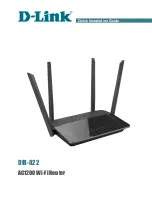
4
Never start the tool when the bit is engaged in the
material.
The bit-cutting edge may grab the material,
causing loss of control of the workpiece.
Feed the workpiece only against the rotation of the bit.
Do not “back feed” the workpiece into the bit.
The bit
rotates counterclockwise as viewed from the top of the table.
“Back feeding” will cause the workpiece to “climb” up on the
bit, pulling the workpiece and possibly your hands into the
rotating bit.
Do not feed the workpiece into the bit where the majority
of the workpiece is between the fence and the bit.
This
creates a “fence trap” which is a hazardous situation due to
the bit being exposed. This will cause the work to “climb-cut”
away from the tabletop and may lead to loss of control during
operation.
Do not cut material that is warped, wobbly, or otherwise
unstable. The router table is designed to cut flat,
straight, and squared materials. If the material is slightly
curved but otherwise stable, cut the material with the
concave side against the table or fence.
Cutting the
material with the concave side up or away from the table
may cause the warped or wobbly material to roll and kick
back, causing the user to lose control.
Use auxiliary infeed and outfeed supports for long or
wide workpieces.
Oversize workpieces without adequate
support can flip off the table or cause the table to tip.
Use push stick, vertically and horizontally mounted
featherboards (spring sticks), and other jigs to hold
down the workpiece.
Push sticks, featherboards, and
jigs eliminate the need to hold the workpiece near the
spinning bit.
Never let go of the workpiece when routing until the cut
has been completed and the workpiece is completely
clear of the bit.
Such precautionary safety measures reduce
the risk of injury and property damage. Featherboards aid in
holding the workpiece in position when routing on a router
table. They are not intended to hold the workpiece in place
alone when the workpiece is in contact with the bit, or at any
other time when the bit is turning.
Always hold the workpiece against the router table fence
when routing.
Such precautionary measures increase
accuracy in routing and improve control of the workpiece,
reducing the risk of injury.
Never leave the router unattended while it is running or
before it comes to a complete stop.
Such precautionary
safety measures reduce the risk of injury and property
damage.
Do not use the table as a workbench or work surface.
Using it for purposes other than routing may cause damage
and make it unsafe to use in routing.
Never stand on the table or use as a ladder or
scaffolding.
The table could tip or the cutting tool could be
accidentally contacted.
When servicing the tool, use only recommended
Bosch replacement parts. Follow instructions in the
Maintenance section of this manual.
Use of unauthorized
parts or failure to follow maintenance instructions can result
in personal injury.
Some dust created by power sanding, sawing, grinding,
drilling, and other construction activities contains
chemicals known to cause cancer, birth defects, or other
reproductive harm. Some examples of these chemicals
are:
•
Lead from lead-based paints
•
Crystalline silica from bricks, cement, and other masonry
products
•
Arsenic and chromium from chemically treated lumber
Your risk from these exposures varies, depending on how
often you do this type of work. To reduce your exposure to
these chemicals, work in a well-ventilated area, and work
with approved safety equipment, such as those dust masks
that are specially designed to filter out microscopic particles.
Additional Safety Warnings for Router Tables
Содержание RA1181
Страница 33: ...33 Notes ...
Страница 97: ...97 Notas ...
Страница 98: ...98 Notas ...
Страница 99: ...99 Notas ...





































